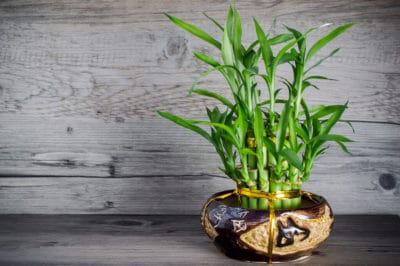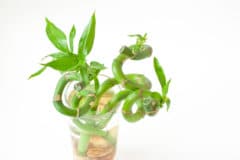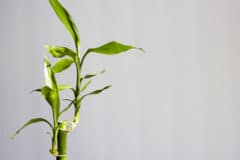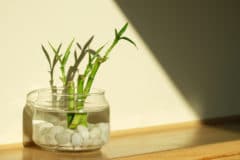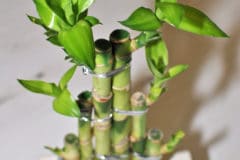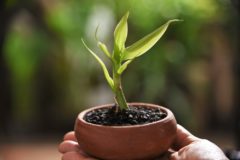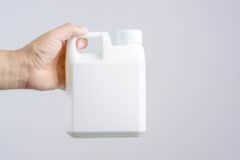Is Lucky Bamboo Really A Bamboo?
Although it does look rather like a bamboo, lucky bamboo is actually a Dracaena. What you find in stores may be either Dracaena sanderiana or Dracaena braunii. A native of Cameroon in West Africa, this tropical plant belongs to the same group as the edible asparagus and various lilies. It is typically green in color, although some varieties may have leaves striped with white or yellow. Mature plants may develop flowers.
Does Lucky Bamboo Have Other Names?
Lucky bamboo is known by quite a few different names. Oddly, only two include the actual name of the plant. You may find it under the following names:
- Belgian Evergreen
- Chinese Water Bamboo
- Friendship Bamboo
- Lucky Bamboo
- Ribbon Dracaena
- Ribbon Plant
- Water Bamboo
- Sander’s dracaena
- Curly bamboo
- Goddess of mercy plant.
Can I Grow Lucky Bamboo Outdoors?
As a tropical rain forest plant, lucky bamboo needs similar conditions outdoors. That means high temperatures and high humidity. If you live in USDA zones 8 through 11, you could certainly move it outdoors in summer, but make sure you keep it very well watered. Temperatures below 65°F (18°C) to 70°F (21°C) may cause damage to leaves. Make sure the plant stays out of direct sunlight.
Can I Grow Lucky Bamboo From Seeds?
Assuming you can find lucky bamboo seeds from a specialty grower or seed house, you may be able to grow it from seed. The seeds are fine and should be planted on top of soil and covered with a thin layer or sand or compost. Keep soil constantly moist and make sure the seeds are not subjected to temperature swings. Transplant when the seedlings have at least four leaves.
How Do I Propagate Lucky Bamboo?
Cuttings from the mother plant are the preferred way to grow new lucky bamboo plants. Take one or more trimmings that include at least one leaf joint. Place them in water (preferably distilled or rainwater) and change the water every few days until roots emerge. You can also push the leaf node below the soil in a pot. Keep moist and warm until new growth begins.
What Kind of Soil Does Lucky Bamboo Need?
Commercial potting soil will work well. You can also mix your own with one part garden soil, one part leaf mold or compost and one part sand, perlite or granite. The most important aspect of planting lucky bamboo in soil is to choose one that drains well. Before you plant, put soil in the pot and add water to check how well it drains. Add more sand or perlite as necessary.
What Kind of Containers Should I Use for Lucky Bamboo?
If you are growing in water, lucky bamboo will do well in pottery or glass bowls. However, opaque containers are less likely to develop algae. Cover the bottom of the container with rocks, glass chips/beads or marbles so only the very bottom of the plant and its roots are in the water. Any container that drains well can be used for lucky bamboo grown in soil.
How Do I Water Lucky Bamboo?
You can actually grow lucky bamboo in water (see below). If grown in soil, water enough to keep the soil moist but not soaking. Check the plant every day to make sure the soil is not getting dry. Lucky bamboo kept in an area where drafts from a heating duct or window can reach the plant may dry out more quickly. Don’t use water with chlorine or fluoride.
How Do I Grow Lucky Bamboo in Water?
Lucky bamboo can easily be grown in water. Use purified or distilled water, or rainwater. Avoid water that is chlorinated, has been chemically softened or contains fluoride. Keep about two inches of water in the container. The roots but not the plant stem should be in the water. Change the water at lest every two weeks.
What are Lucky Bamboo’s Light Requirements?
In its natural habitat, lucky bamboo grows in dappled shade from taller plants and trees. It will do best in bright but indirect light when grown indoors. An east or north-facing window is usually a good choice. Keep it out of direct sunlight, which will burn the leaves. However, it will not do well in a low light condition and will become stunted.
How Do I Fertilize Lucky Bamboo?
Although lucky bamboo will grow in water, it will do better with occasional fertilizer. Use a weak liquid organic fertilizer and add only a drop or two to the water. Plants grown in good soil will need fertilizer once or twice a year in spring or summer. Just water the plant with a weak liquid fertilizer solution.
How Do I Shape Lucky Bamboo?
Lucky bamboo can be shaped into intricate arrangements or spirals, but it takes considerable time, skill and patience. Let stalks grow, then gently guide by tying them or weaving them together. To make them spiral, place on their sides with the top toward a window. Rotate the plant every few days in the direction you want to spiral to go.
Does Lucky Bamboo Develop Flowers?
Lucky bamboos definitely bloom well in the wild. However, the plant must be mature (several years old). It’s unusual for lucky bamboo to bloom when used as a houseplant, and conditions would have to be as close to those in the wild as you could make it. If you really want blooms from your plant, consult an expert grower for tips and suggestions.
Does Lucky Bamboo Have Any Pests?
Scale and spider mites are about the only insect problems lucky bamboo is likely to develop. You’ll notice a white sticky substance or cotton-like webbing on the plants. If growing in water, remove the plant from the container and scrub the container thoroughly with soapy water. Refill with fresh water and change it regularly. Spray plants (including those grown in soil) with insecticidal soap and rinse thoroughly.
What Diseases Affect Lucky Bamboo?
Powdery mildew, leaf spot and rots are the diseases most likely to affect lucky bamboo. Mildew is a fungus that is promoted by high humidity, leaf spot is caused by a virus and rots can be viral, fungal or bacterial. Controlling all of these is difficult and in most cases, it’s better to throw the plant away and get a new one.
What Do I Do About Algae?
Clear class containers used for lucky bamboo are particularly prone to algae. To remove it, temporarily place the plant in a glass jar with a little water. Thoroughly scrub the container and rinse well. Put in new rocks or glass chips. Add plant and new water to container. Soak dirty rocks or glass chips in soapy water with bleach, rinse very well and let dry for a week or two before reuse.
How Long Does Lucky Bamboo Live?
Most lucky bamboo plants used as houseplants will live several years. However, if you care for the plant properly, it could live much longer – perhaps 20 or 30 years. The reason for the wide variation is that the indoor conditions where most lucky bamboo grows doesn’t mimic the hot, humid rain forest that is its native habitat.
What Do the Ribbons on Lucky Bamboo Mean?
Lucky bamboo is often grown in shapes. If ribbons are added to the arrangement, they have specific meanings. Ribbons may be used singly or in combination. The meanings are:
- White – purity and confidence.
- Red – fire.
- Blue – wisdom, serenity, calm relaxation and healing.
- Purple – mental healing and spiritual awareness.
- Orange – concentration.
- Yellow – cheerfulness or friendship.
Do the Number of Stalks Matter on Lucky Bamboo?
Some people believe the number of stalks on a plant signifies luck or other benefits. In general, the more stalks on a single plant, the better. Three stalks is considered a favored combination of happiness, long life and wealth. However, four stalks has negative connotations and can mean death or a death wish. Nine is another good luck number and 21 is considered a very powerful blessing.
